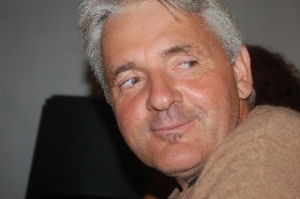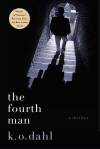SCENE OF THE CRIME Hosts Norwegian Mystery Author, K.O. Dahl
The Other Oslo
March 2, 2010 by Scene of the Crime
 Kjell Ola Dahl has been called the Henning Mankell of Norway. The author of eleven highly acclaimed police procedurals, most of which feature Oslo
Kjell Ola Dahl has been called the Henning Mankell of Norway. The author of eleven highly acclaimed police procedurals, most of which feature Oslo
detectives Frank Frølich and Chief Inspector Gunnarstranda, Dahl was
introduced to English-speaking readers with his 2007 novel, The Fourth Man (originally published in Norwegian in 2005). Since then other books in the series have been published, including The Man in the Window in 2008, and The Last Fix,
2009, which won Norway’s prestigious Riverton-prisen for Best Norwegian
Crime Novel of the Year, and was nominated for a raft of other literary
awards.
Known for his psychological insights and questioning of modern society, Dahl writes tight police procedurals with more than a touch of wry humor injected. His character Gunnarstranda has reached something
of an iconic status in Norway with his comb-over and grumpy attitude.
Equally important in the novels is the setting. Oslo, Norway, is Dahl’s
domain, and he brings to the city an insider’s keen eye for detail and
nuance.
Kjell, thanks so much for taking the time to talk with Scene of the Crime about your work and the importance of place in it.
First, could you describe your connection to Oslo.
My family moved to Oslo when I was a kid. We moved in to a small flat on the eastside. After a couple of years we moved further west. When I was younger I loved to explore the city, and found myself being
flat on the eastside. After a couple of years we moved further west. When I was younger I loved to explore the city, and found myself being
one that knew neighborhoods and parts of the city my friends didn’t
know. Later, when I was a student I worked as a cab driver, mostly
working night shifts. Today I do not live inside Oslo, I live in the
countryside, some sixty miles away (90 kilometers). My mother still
lives in Oslo, my publisher is there and most of my friends live in
Oslo. I visit Oslo quite often. Still I love driving, bicycling or
walking around the city exploring new sites when I do research.
What things about Oslo make it unique and a good physical setting in your books?
Many things actually. The geography is quite unique. The city is surrounded by hills except on the south side, where the harbor leads out the Oslo fjord. The hills are areas for hiking. There is a
combination of urban life and huge surroundings that is a perfect
location for more “gothic” environments. One other thing about the city
is that it is continually in a process of change. Areas which a few
years ago were industry now have become neighborhoods where people live
their daily life. The seaside is always changing too. In Oslo there
are clearly different districts which give good locations. When I
invent a new character I am always trying to give him or her a
biography and the place they live is always important.
Did you consciously set out to Oslo as a “character” in your books, or did this grow naturally out of the initial story or stories?
 I think this grew naturally out of the stories. I remember when I wrote the first book in this series, I worked almost the same way as I do
I think this grew naturally out of the stories. I remember when I wrote the first book in this series, I worked almost the same way as I do
now. I walked around until I found the exact spots – where the
different character lived, where the killing took place etc. But – I
wasn’t that conscious about how important the location was. In my
latest book I discovered I had taken the process a bit further. I was
continually asking myself: In what location could this incident take place, where should it take place? I was eager to make the choice of location reflect parts of conflicts in the specific scenes.
Writing a series means that I am partly bound up to the characters’ universe. My heroes (or anti-heroes) are police officers doing their job in Oslo. If I want some of the action to take place in
other locations I have to motivate that move.
How does Detective Chief Inspector Gunnarstrandainteract with his surroundings? Is he a native, a blow-in, a reluctant or enthusiastic inhabitant, cynical about it, a booster? And
conversely, how does the setting affect your protagonist?
My protagonist grew up in Oslo, in the old eastside – a district called Grünerløkka. Then this district was working class, poor people living there, no WC, poor heating etc. Today this district is
very posh, all the westside youngsters are living their posh lives
here, eating out etc. This fact is having an impact on him. He is very
aware of how the city influences his life, but he is a very cynical
character. He knows that his life is a moment in time.
What kind of local reaction has there been to your works, beyond the fact that the books are a huge success in Norway.
I often get feedback from readers on this subject. People like to try  to catch me. They can point out e.g. I have that view from my apartment and that tree isn’t there etc. Some time reviewers have reflected on locations. Also, being a Norwegian writing crime fiction, a lot of reviewers reflect on the
to catch me. They can point out e.g. I have that view from my apartment and that tree isn’t there etc. Some time reviewers have reflected on locations. Also, being a Norwegian writing crime fiction, a lot of reviewers reflect on the
success of nordic crime fiction in general.
Of the novels you have set in Oslo, do you have a favorite book or scene that focuses on the place?
In my latest book, the main theme is about friendship. My protagonist and his friend have a troublesome past and his friend is involved in a case. When these two guys finally decide to make up, they
literally move into the Oslo underground – the sewer system.
Who are your favorite writers, and do you feel that other writers influenced you in your use of the spirit of place in your novels?
I find it very difficult to list favorite writers. I can go wild about books when they are good. These days I am reading the English writer R.D Winfield, who died some years ago, and who wrote
brilliant books. He is very good with locations, I also think the
Spanish author Montalban is good with locations and of course Chandler
and Ellroy.
What’s next for your Gunnarstranda and Frølich?
The harbor of Oslo, deep waters.
Thanks so much, Kjell, for your comments, and please keep the Nordic crime invasion going on these shores.
For you readers of Norwegian and anyone interested, visit K.O. Dahl’s homepage.
Welcome to
CrimeSpace
CrimeSpace Google Search
© 2025 Created by Daniel Hatadi.
Powered by
![]()
You need to be a member of CrimeSpace to add comments!